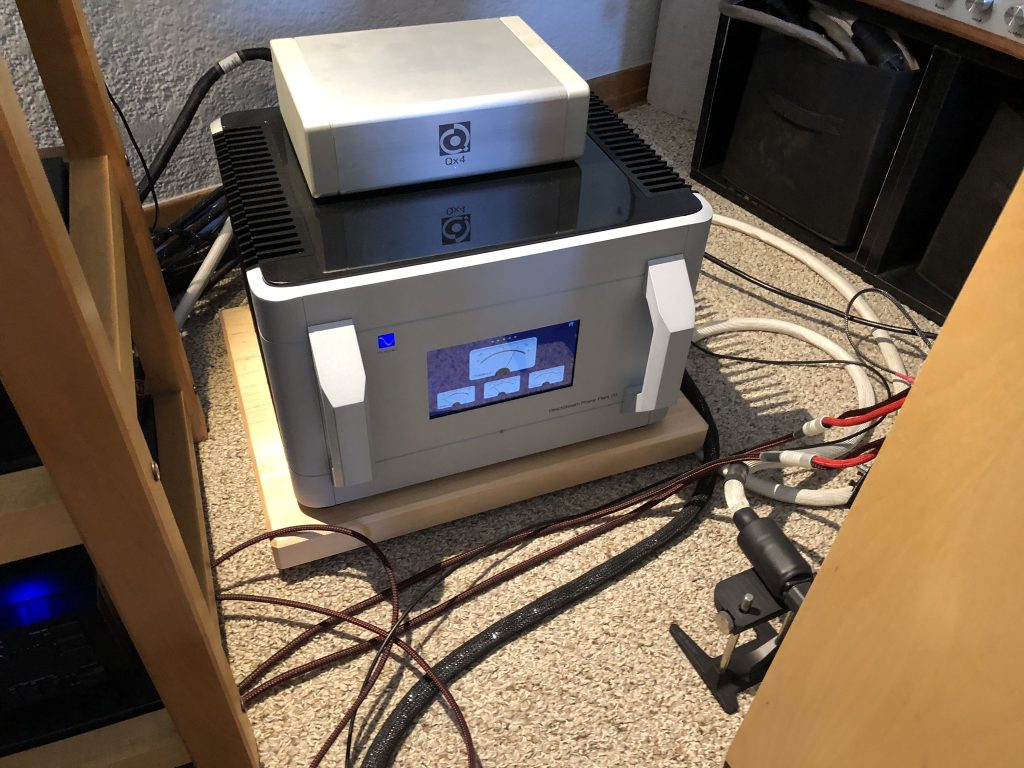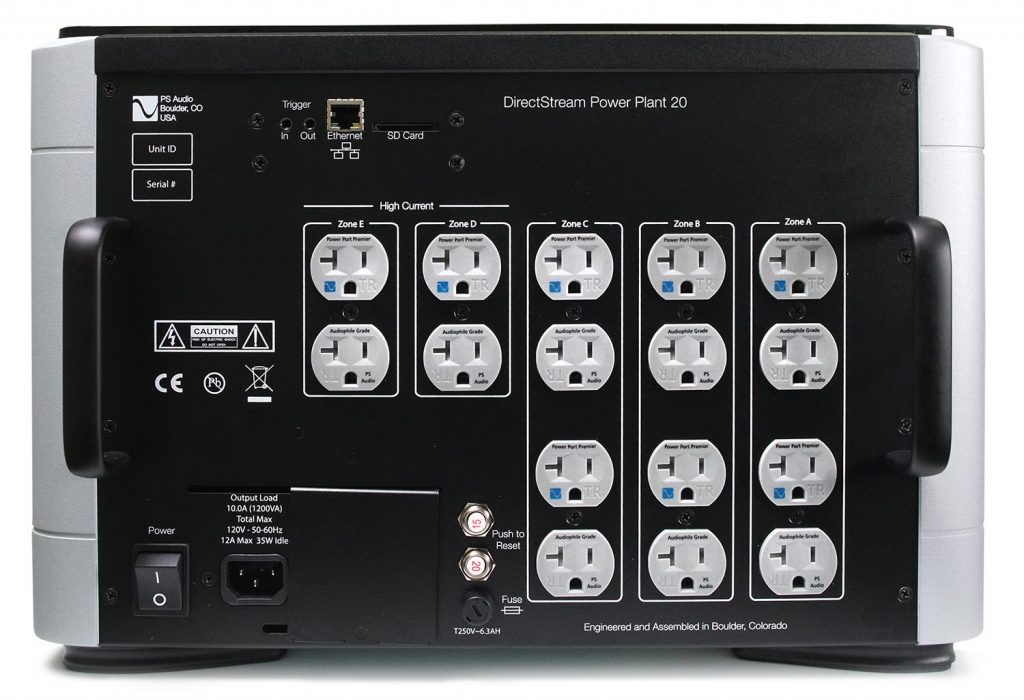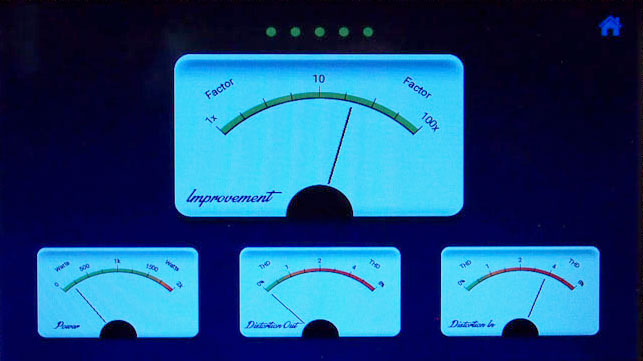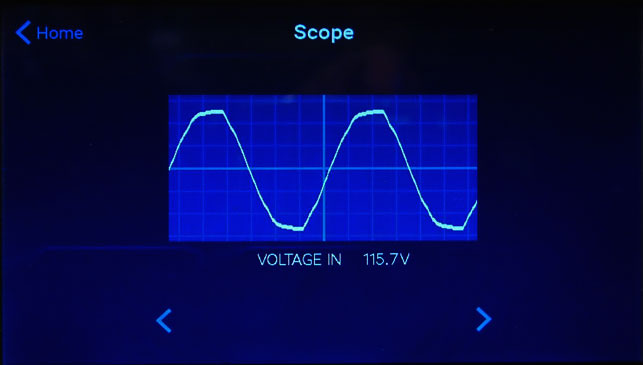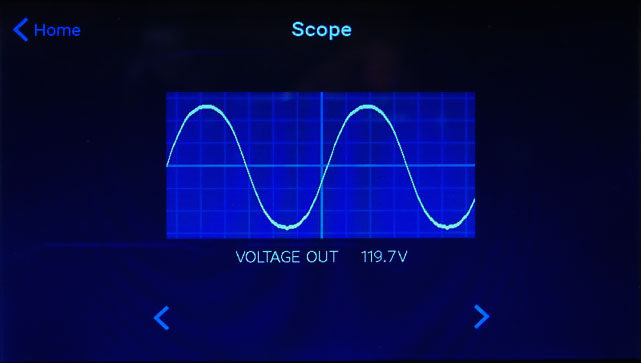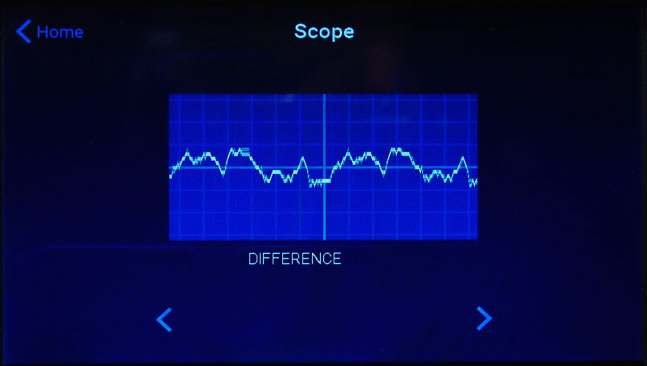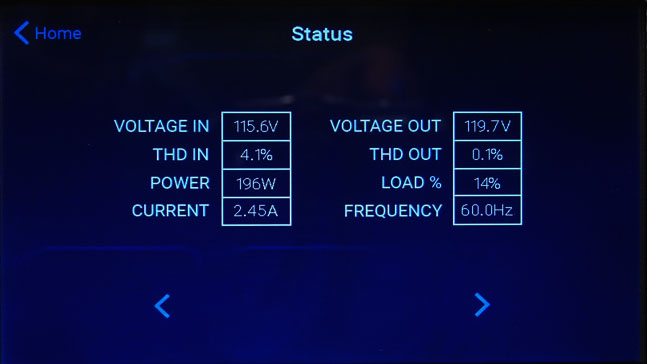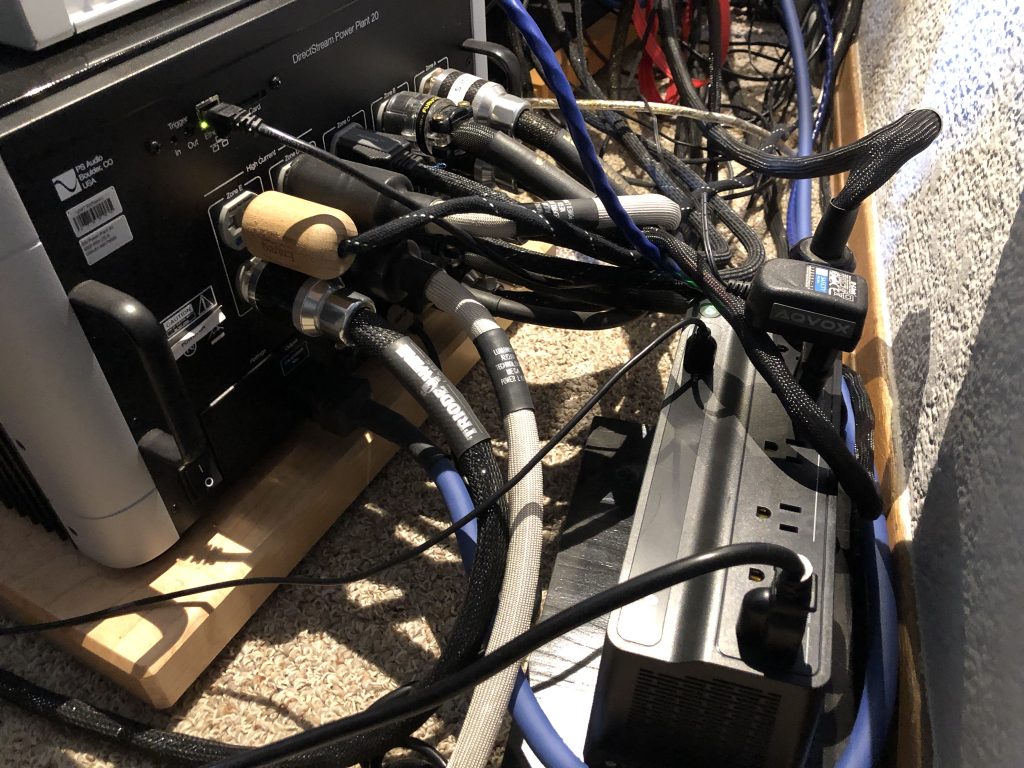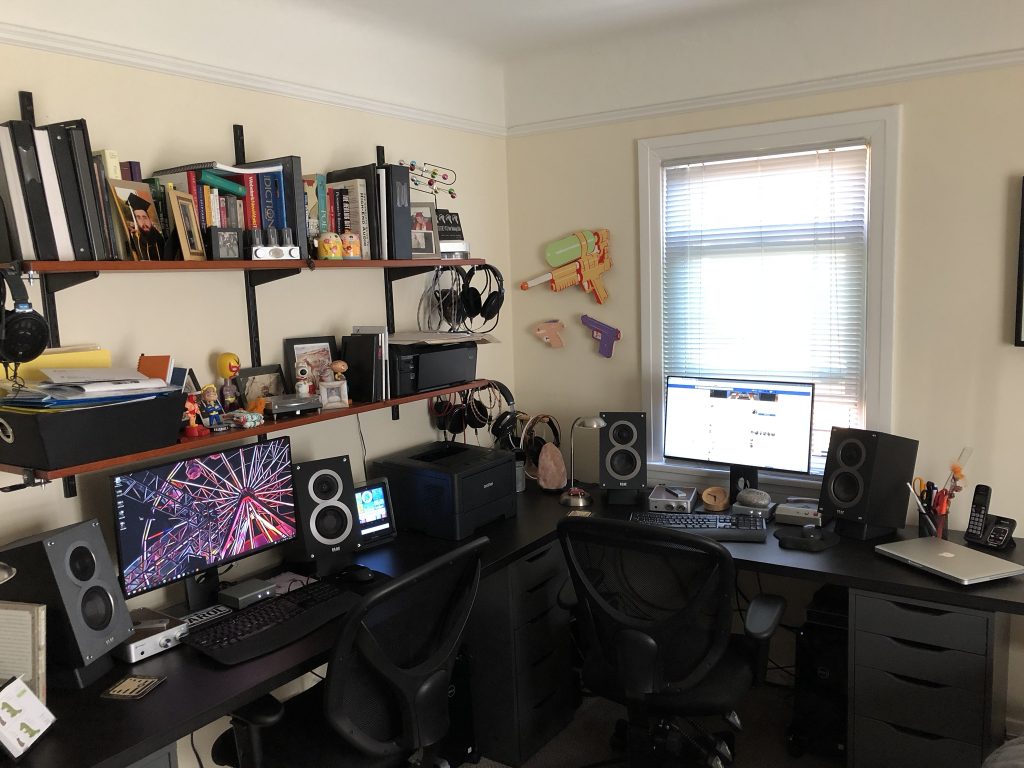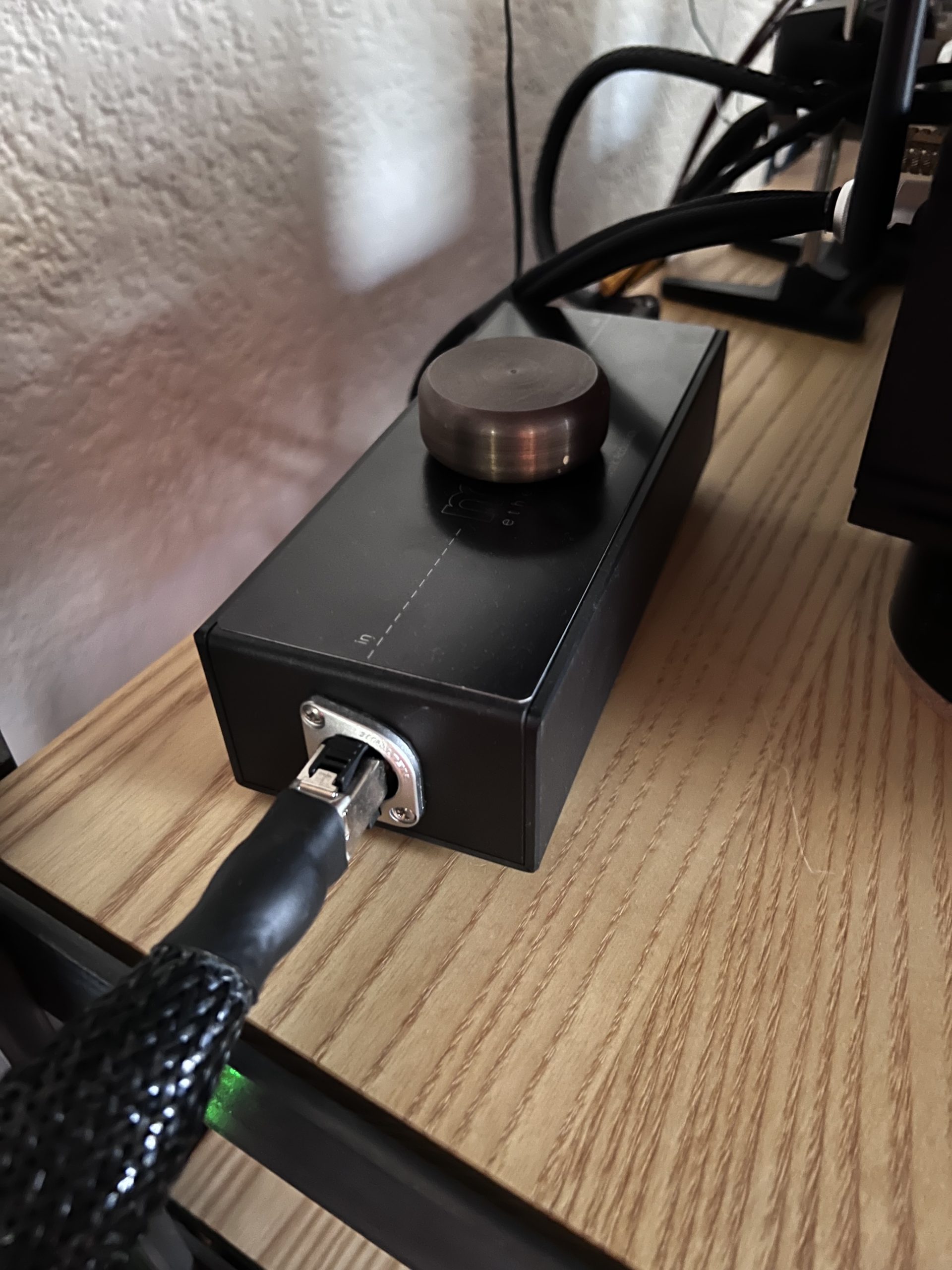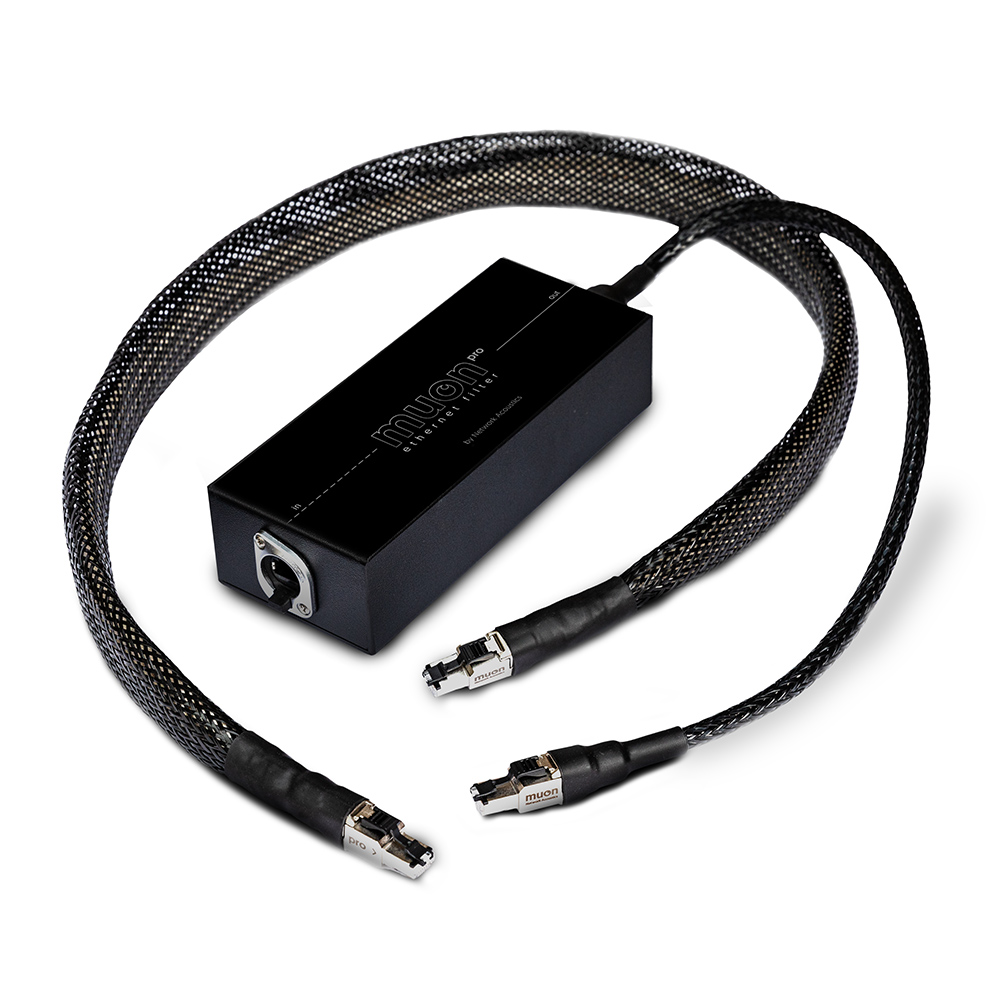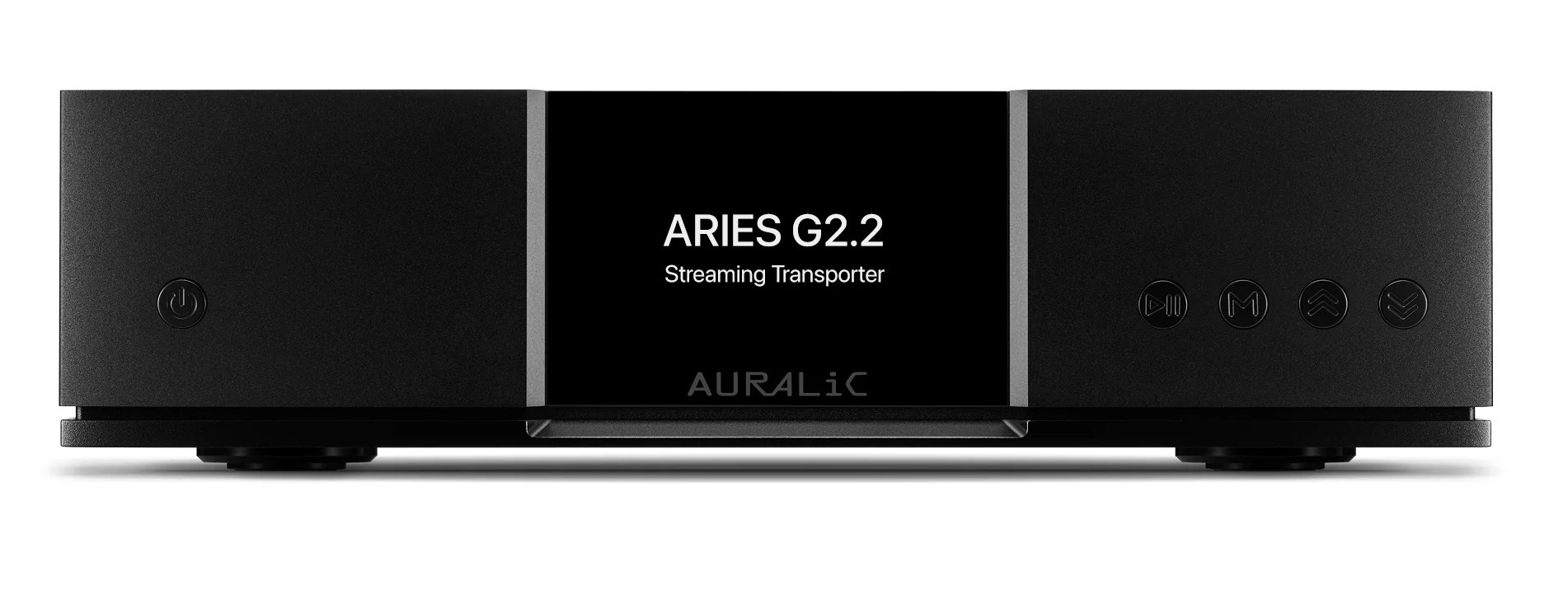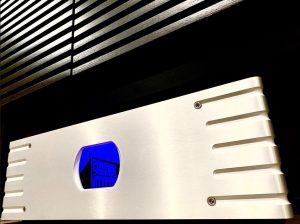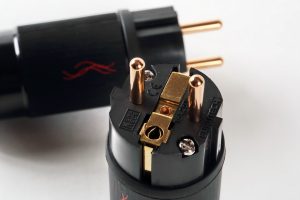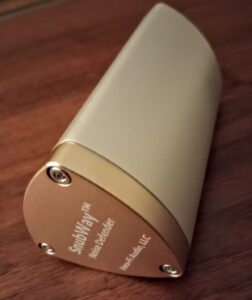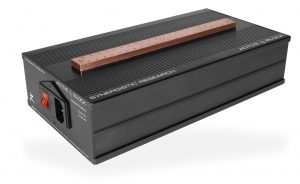So, when it comes down to getting the best, make that the very best, that one's system can produce sound wise in your room, after all is said and done… let's make sure that the AC that is feeding our components is as good as it can get—like with any AC filtration device or a regenerator like the PS Audio P20. Yeah, I know the counter argument is that any well-designed power supply should be rather impervious to noise and what not that we find riding along on the incoming AC. That whatever is "there" should not make a difference in how a component does what it does, but it does. At least here it does. I can hear the difference in our sound when using various AC "filtration" units. And yeah, I guess when I say I can hear a difference, it could simply be that whatever I am using is not so much helping the component do what it does by "filtering" out or changing the AC in some way, but simply changing the way the component sounds—making it sound "different" by adding something to the AC in some way. Or is this "difference" a result of them (whoever designed the component) working in an environment with bad AC (fluctuating and dirty) or good AC (stable and clean)? Does it matter? Maybe, maybe not so much since I have no way of knowing if the AC here in my house is going to be like, or not like, the AC there in their environment.
Alright so I brought up a few points here, but I am not an engineer, so cut me some slack with the following thoughts.
If a component has a well-designed power supply, then should dirty or fluctuating AC be an issue? Should not the power supply be able to deal with these issues? I would think it should, or could, assuming it is well designed, and in terms of where we stand today, in terms of engineering, they should be. Right? I mean I would hope so. Of course, perhaps it was not designed to deal with everything that is evident in today's residential AC environment, so some things can (could) cause a problem. Unstable AC, DC from lights and whatever… digital noise, and so on. Perhaps these issues tax the power supply and do in some way(s) affects its ability to power the component as intended?
Noise and crap do exist in the AC and for sure it is fluctuating, and in many cases that 120 is never 120 but whatever. Here at my place in Long Beach, CA it is never 120; it fluctuates between 112 and 116. Heck, once it dropped as low as 105 which resulted in a call to Edison for a remedy. They came out and found the issue and all is good… but I am only at 114- 116. That cannot be optimum for my system.
Different AC "filtrating" devices use different approaches and/or components to do what they do. Some use proprietary circuits, filters, and what not to "clean" up the AC. To filter out the noise or at the very least to lower it to a point where it is less harmful. Though again the argument will be, "Any well-designed power supply is immune to this, so you are fooling yourself!" Yeah well whatever. Proof is in the pudding... or listening.
Having used several different products to filter this noise and whatever… the music always changed in some way. I heard more music with less in the way. Things opened up, details and presence were increased in a way that allowed me to enjoy our music longer and with greater appreciation. Engagement.
Are these AC devices coloring the sound? Maybe. There is a lot in the way of the AC to travel through that can certainly impact things sonically. Capacitors, wire, transformers, resistors… materials. Everything has a sound and everything can impart a sound on the sound. So maybe we are just hearing these pieces all put together? A sonic seasoning? Or are they actually doing what the manufacturer says they are doing—removing noise and crap so we can better appreciate the music with less in the way? And… all the while adding their own sound to the AC? I tend to fall to these last two conclusions. Noise is measurable and I have seen enough charts and graphs of before and after to know that many are reducing the various (make that specifically targeted) noise on the AC to whatever levels. So, they are doing something that is measurable. And using them, it is audible what they do, and... how they do what to they do with what they do it with. Both lower noise and whatnot, but they do it differently. And hence might (do) impart a different sound on the music and what they use to do it. And different audio components (sources, amplifiers, preamplifiers, etc.) can react differently with different AC filtering devices. Yours reacts differently than mine. So, things sound different. More of what I want to hear—and vice-versa with you. Different does not necessarily mean worse or better, though I suppose it could, but then that is also pretty much subjective. All this leads to different strokes for different folks; you like device x and I like device y. We want, and hear things differently. We value different aspects of the sound or presentation... we find what makes the music sound like what we want to hear. What we think is right.
But, none of these devices can really change the AC in terms of what it really is… they can only address noise and the like that is riding on the AC. That is good, but it does not solve the issues of fluctuating or a bad 120Hz AC sine wave. You still are getting crappy AC… you are just getting cleaner crappy AC. Which might be all you are after... or all that you need to make you happy.
So, what can we do if that is not enough? Well PS Audio has been in the business for a long-time making various AC regenerators. These regenerators not only clean up the incoming AC, they regenerate new AC that is pretty much perfect. Only have 116 volts coming in? The various regenerators from PS Audio will give you a nice and prefect 120… or something else you prefer because that makes your music (components) sound (perform) that much better. Meaning, yes, the output voltage is adjustable to a degree and yes, one can do even more than just that to the AC output of the regenerators.
Here are some options or features that the P20 brings to the table…
"Voltage - you can globally adjust the output voltage for the P20. Bear in mind that the P20 will output the same voltage from all zones. They are not individually adjustable." Mine is set to whatever it is to get as close to 120 as possible - I am seeing 119.7.
"Variable MultiWave Strength - this feature can be enabled by pressing the MultiWave button on the Home screen. Variable MultiWave empowers users to vary the strength of the MultiWave output according to the needs of the equipment and the resulting performance benefits. To toggle this feature on and off simply press the Waveform Button in the Main screen." Mine is at 4.
"Phase tuning - increasing or decreasing this will move the point at which the P20 detects the incoming waveform as the wave crosses the 0 Voltage point. In places where the AC power is especially poor, making small adjustments to this setting can potentially lower the THD output. The best recommendation would be to keep this at zero unless you are seeing THD output higher than 1-2%." Mine is at zero.
"Auto-Tune button - calibrate the phase setting to the optimum setting for your input power. This only needs to be performed whenever the unit is moved to a new area to maintain optimal performance." I have not done this yet... yikers!
"Mode setting gives you the choice of High Regulation or Low Distortion. High Regulation is the default mode and ensures that the P20 will output the voltage very precisely at the expense of potentially higher distortion (THD). Low distortion mode ensures that the P20 will output the lowest possible distortion at the expense of more fluctuations in the output voltage. Choose the option that best suits your needs." I went with High Regulation as the THD is really, really low.
And…
"The output impedance of the P20 is extraordinarily low and blocks noise from traveling back into the P20. At lower frequencies this is the only way of doing it since any sort of passive isolation (such as filters) would ruin the whole point to the regenerator – to provide AC regulation (low output impedance)."
"There are various ways we reduce noise coming into the regen. There are passive filters for rejecting RF and an active correction circuit for frequencies within the audio band. This correction allows for the output impedance and noise to remain very low, even at high frequency."
And some more from the site that puts the P20 into context…
"Power conditioners are passive collections of capacitors, resistors, transformers, and coils of wire which lack the ability to add missing energy back onto the power line. Power Plants use active components, like those found in large and powerful audio amplifiers, to store and release energy for peak demands (up to 70 amps), rebuild the AC signal and produce clean, clear, distortion-free, regulated AC for your equipment. When performance matters, why compromise?"
"DirectStream Power ushers in a new world of purity with a clean, analog-like DSD generator. A Power Plant regenerator's precise output is tied to its internal sine wave generator, not some coal-fired monstrosity feeding miles of noisy powerlines. The P20's FPGA based DSD engine delivers the cleanest, lowest noise sine waves of any regenerator in the world."
"System performance is improved by lowering the AC impedance, ensuring dynamic AC regulation, and providing instant, unlimited reserves of clean power of up to 70-amp peaks."
Here are some specifications form the PS Audio website....
- Maximum Peak Load: 3600VA
- Voltage Regulation: >1V
- Output Distortion (Resistive Load): <0.5%
- Output Distortion (Reactive Load): <0.5%
- Output Impedance: <0.005 ohm
- Noise Reduction: 100kHz – 2MHz >80dB
And 16 outlets! Okay with my system I need more, so I use a power strip of rather highly quality for lesser items, but with 4 for high current, and 12 for regular lower current components, this is going to pretty much fit anyone's system. And man oh man. Think of this like one big amplifier. It weighs over 100 lbs in the box and takes up considerable real-estate. Our FedEx guy carried it from the truck by himself and all was good till he tripped over the front step and fell into the living room. He looked at me with an expression revealing that he hoped he could walk away alive. I was more worried that he was hurt, but all was good. The box took a tumble, but the P20 came out in perfect shape. Hats off to PS Audio and how they box their components.
And so with the P20 plugged into one of the dedicated 20 Amp AC lines and everything, and I mean errything, plugged into the P20, here is what we are seeing via the front panel metering options...
All of which means what with respect to what we are hearing?
Well yeah… holy cow what a difference. There is a way greater ease to the music than before. And less sonic seasoning too. Well, at least I think so. My current AC filtration device (two actually) is the way recommended Dark Matter Stealth from Tweek Geek. Using all that Jack Bybee knows, along with the ingenuity and creativity of Michael Garner, this is as good as I have ever heard our system (er, music) with a passive device. Highly recommended, and even when compared to the P20, any sound that the Stealth might be adding to the music is nil. As transparent as I have heard, all the while lowering of the noise floor times 10 (Dean Sieslove writes about the Stealth HERE). But the Stealth cannot do anything with the AC here in terms of fluctuations and the havoc that does to one's system. Nor can it fix the lower voltage seen at 114-116? No, not going to happen. But I really would like to see 120 if I could and a nice clean sine wave too. I get that with the P20. For sure the Stealth does everything else I want and in spades... I just want more than it can do. If your AC is good in terms of voltage. then the Stealth is going to be as good as anything out there... I love mine and cannot recommend it high enough—audition one today! But with the P20, the music just sounds more stable... and solid, with an increased thereness. Space and presence are improved. Lowering the noise floor even further? Maybe so. Hard to tell. Maybe, maybe not.
Plugging the P20 into the Stealth showed a slight reduction in THD on the AC via the P20's meter, but nothing else. So, while the music here does sound way better with the Stealth than without, what it is doing to the AC and what the P20 are doing is not the same. Different approaches. At least with THD but certainly in terms of providing a true 120Hz sine wave and getting that 116 to be closer to 120. But what about plugging the Stealth into the P20? Yeah, did not work for me... not sure I cared for what I heard and the idea kinda voids what the P20 is all about.
But back to the P20. Like I said, I have everything plugged into it and simply find our music to be more dynamic and alive. Greater separation and resolution… and all with no hint of harshness or whatever. No glare or grit. But, more visceral and, well... more overall engagingly so. A result of stable AC? A result of a cleaner sine wave? A result of lower noise and THD? Am thinking yeah, for sure.
A tangled mess we have woven.
Note: In prior use, neither the Vandersteens or the PS Audio BHK 250 amplifier were plugged into the Steatlths. Instead they went directly into the wall outlets (20 amp dedicated circuit) where they were fed AC. Now, all are being fed AC from the High Current outlets on the P20. So, I am hearing not only what the P20 can do for the rest of the system, but also the three amplifiers.
Bass seems to go lower with a wonderful sense of tightness… or rightness, especially as evident from the subs in the Vandersteens. Slam and punch, texture and presence. Palpable as all get out, and, as I said, texture… oh man… where there is, there is... texture.
The P20 does not appear to be editorializing the music, or adding any colorations. Not a unit if one wants a "sound," though I suppose it could via all its wire, plugs, and parts, but then since I have no idea what my music should sound like, only what I like it to sound like… yeah, I could be heading West when I wanted East. Even so, both Carol and I are awfully pleased with the sound here with the P20. We do have the MultiWave set to 4 (from 1-6) and like what that does too. To quote Paul, "Technically MutliWave is the same thing as adding more capacitors to your connected gear's power supply. You can actually see the power supply ripple go down—which is what you'd see with bigger caps." A bit more dynamic and effortless.
Extended, airy, articulate, and easy to listen too... crap stripped away and stable AC at a voltage that allows everything to run easy peasy. You can easily hear the difference. Now whether the price equals that (the P20 is $9999), I cannot say, only you can decide if that is worth the expense. PS Audio does offer less expensive units that offer, well... less. And so that might be the way to go. I only went with the P20 based on the total watts my system used—and the total suggested the P20 would be the best option. Of course once plugged in I realized I could have gone with perhaps the P15, but then I give up outlets! The P20 is way more than I really needed, but then it does offer me a lot of headroom, so there we go.
I am getting a clean 119.7 at the moment on a hot muggy day here where I am sure everyone who has them are running every fan or air conditioner at full blast. The P20 does not run hot, nor does it make a sound. It like i said, it is big and heavy, so find a good spot to put it and leave it.
Simply put, we love the P20 and cannot recommend it highly enough. It not only gets you clean AC, it gets you stable AC at the voltage you want. I know there is more to go into here, that we are really only scratching the surface with the P20's options, but then I am at that point where I would rather listen to music then play with gear. Plug and Play.
As to the music we used to audition the P20... uh yeah, sorry but we listen to a ton of stuff and pretty much put on whatever. At this point in our reviewing career, we do our best to avoid having test music, though for sure there are some titles or songs we listen to more than others. For us it is the music and not the gear. The gear is just a vehicle to deliver our music.
I mean if I had to make a list of recent music it would include music from Eno, Massive Attack, Mogwai, The Notwist, The Cure, Bowie, New Order, OSME, Howe Gelb, Calla, Bohren & Der Club of Gore, The National, Aleski Perala, Godflesh, FAX, HiM, Lustmord, Andy Stott, The Soft Moon, UNKLE, Flavor Crystals, The Telescopes... so on.
Wait!? Who is Bohren & Der Club of Gore? You have got to give these guys a listen. Not what one expects with the name Bohren & Der Club of Gore. Stellar in every way.
Oh, but there is more. Well, see I had zero 20 amp AC cords here to use with the P20, so with a little help from Tim Stinson at Luminous Audio, he sent me his Mega Power Lynx A/C Power Cord ($699), and then Cardas helped out by sending the Clear Power ($920), and then Pangea helped by sending the AC-9SE MKI ($199.95). I also have the Mega Power Lynx A/C Power Cords on the Vandersteens where they do wonders in getting the best from the subwoofers - highly recommended for amplifiers.
Anyhow each cord brought their own magic, and compromises when used with the P20. I am not going to say one is better than the others, just that they are different—each with their own subtle but audible flavoring to the music. As such, any of these will bring smiles to those who want to better what a stock cord will do. All three cords were given 4-6 days on the Cable Cooker, and then right on the P20 for a week or so
The Mega Power Lynx A/C was simply wonderful without any sonic caveats... but one has to deal with very strong magnets in the two plugs as well as the issue that the cord does not sound right after being unplugged for any extended period of time—it likes being used! So just repeat the break-in process and all is good. What one gets is a big and dynamic presentation that is fast and articulate. Airy and extended, this is the cord for those who love living fast. Man did this cord work. Highly recommended.
The Cardas Clear Power is very robust and offers the most richness and warmth of the three, though these differences were slight and required repeated swapping in and out—which was a real pain in every way. Way nice too overall with it being perhaps the more complete or balanced of the three in terms of what we heard with our music. A lot like the Mega Power Lynx A/C, we loved how it worked with the P20. Wonderfully musical. Highly recommended and way easy to work and live with.
The Pangea AC-9SE MKI is by far the least expensive, but offers the most bang for the buck. It is simply stellar in every way, though perhaps a tad leaner than the other two in how it revealed things, and perhaps a touch less refined than say the Cardas. Even so, Carol preferred this cord to the others with vocals, in that she found it easier to discern what was being sung. Bass was tight and the sound was big and dynamic. A real winner in every aspect, except man is this thing stiff. Careful routing is required as it likes space to make the bends. Highly recommended.
We can (could) live with any of these. Each has their own strength (personality) and none really made the other two any less attractive sonically. Highly recommended, though naturally someone will end up preferring one over the other—that is a given. As is someone finding that a stock cord is just as good. Us? Well, we want to use them all! Each is too good to give up! And we found that when using any for an extended period of time, well, any of these differences became moot because this became our reference.
PS Audio
Cardas Audio
Luminous Audio
Pangea




